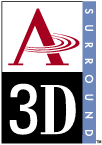Las Vegas, CA. 3D Audio is attracting a lot of attention at the COMDEX Fall’96 exhibition (Nov.18-22) in Las Vegas. The playing field is getting cluttered, as chip manufacturers and audio technology labs step up to grab a share of the add-on sound card market, which is projected to 160 million units by the year 2000.
[SoundBlaster Logo]
The Sound Blaster® standard developed by Creative Labs dominates the PC sound card market today, with about 70% of the installed user base. Most of Creative’s competitors are pitching “3D” sound of some form, supported by Microsoft’s DirectX and DirectSound API’s, to differentiate themselves from Sound Blaster’s dominance (the DirectSound API provides a hardware abstraction layer so developers don’t have to write hardware-specific code).
3D audio comes in several flavors. The standard implementation of 3D PC sound involves enhancement of the stereo field as heard through two speakers, and COMDEX has offered a look at new implementations of this approach from several companies, including Yamaha, Philips, Chromatic Research, S3, Oak Technology, SRS, QSound, and the Sound Blaster folks themselves (with “3D Positional Audio” on the new AWE64 series cards).
At the high end you get binaural simulation (requiring headphone listening for best results) of fully spherical sound localization. This requires complex realtime filtering of the audio signal based on detailed measurements of actual hearing response in the ear. For several years, this has been the domain of extremely expensive DSP systems: for example, a professional system introduced earlier this month at the AES Convention in Los Angeles by Central Research Laboratories (UK) was priced between $40K – $85K (US) depending on the I/O configuration.
At COMDEX, two manufacturers are demonstrating chips that offer HRTF-based spatialized sound for low-cost sound cards.
 Aureal Semiconductor won good reviews for the sound quality of its chip set when it was demonstrated at the AES Convention, and the company is getting a similar response from the less-discriminating (audio-wise) audience at COMDEX. The chip set features Aureal’s ASP301, an optimized DSP engine that provides the company’s Aureal 3D (A3D) spatialization and accelaration support of the DirectSound API; and the ASP311 PCI bus interface chip. The chip set is positioned as an OEM upgrade to existing Sound Blaster cards.
Aureal Semiconductor won good reviews for the sound quality of its chip set when it was demonstrated at the AES Convention, and the company is getting a similar response from the less-discriminating (audio-wise) audience at COMDEX. The chip set features Aureal’s ASP301, an optimized DSP engine that provides the company’s Aureal 3D (A3D) spatialization and accelaration support of the DirectSound API; and the ASP311 PCI bus interface chip. The chip set is positioned as an OEM upgrade to existing Sound Blaster cards.
A3D was originally developed under NASA funding, for use in flight simulators, and later developed commercially by Aureal subsidiary Crystal River Engineering (as the Convolvotron™). The 301/311 combo is capable of processing up to 32 DirectSound audio streams simultaneously, and up to eight independent 3D sound sources. Aureal is currently shipping reference design boards and samples, with production chips scheduled for February 1997.
 Also at COMDEX, VLSI Technology Inc. introduced its SongBird 3D™ DirectSound Accelerator chip (VL82C829), featuring VLSI’s ActiSound™ positional 3D audio. Like the Aureal chip, this one functions as part of a set. The main SongBird processor is the DSP HRTF engine, with interfaces to Dolby AC3 and MPEG audio processors, plus a separate AC’97 codec made by Sigma Tel.
Also at COMDEX, VLSI Technology Inc. introduced its SongBird 3D™ DirectSound Accelerator chip (VL82C829), featuring VLSI’s ActiSound™ positional 3D audio. Like the Aureal chip, this one functions as part of a set. The main SongBird processor is the DSP HRTF engine, with interfaces to Dolby AC3 and MPEG audio processors, plus a separate AC’97 codec made by Sigma Tel.
SongBird also comes with an audio hardware developer’s toolkit called SoundSuite™ (developed by EuPhonics Inc.). SoundSuite is supplied with DirectX drivers for the SongBird chip, supporting the Microsoft DirectSound API. The firmware provides 3D audio positioning, spatial enhancement, DVD audio decoding, wavetable synthesis, audio effects, and Sound Blaster compatible music synthesis.
A SoundSuite development environment is available now, and chip samples will be available in early 1997. The processor will be available in production quantities in the 2nd quarter of 1997, priced at $25 in lots of 10,000.
Speak Your Mind
You must be logged in to post a comment.